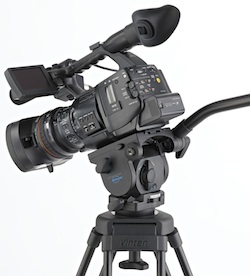
Vinten launched three new tripod heads at IBC covering lightweight camcorders and HD DSLRs to use on OBs and live events.
Its new Vision Blue is a budget high-performance tripod head aimed at “the lightest of camcorders and DSLRs equipped for video”, and “is designed to deliver all the quality and performance users have come to expect from a Vinten Vision head,” incorporating infinitely adjustable, Perfect Balance and LF drag technology. This functionality was previously only available with its more expensive Vision 3AS and above. It can carry payloads between 2.1 – 5kg.
“All professional camera operators want the same things: smooth, perfectly balanced movement, fast set-up and security against unwanted movement; and a reliable product that will provide long service,” said Peter Harman, Vinten product manager. “That is true for all our customers, but up until now there has been a gap in the market for a broadcast quality tripod system that can genuinely balance the smaller, lightly accessorised camcorders that are so common today, without any compromise on creativity.”
Its new Vector 750i blurs the distinction between Vinten and its sister company, Vinten Radamec, bringing the sort of electronic intelligence associated with VR’s studio robotics to the realm of outside broadcasts and live events. The 750i is Vinten’s first encoded pantographic head, and was developed with OB customers, such as SportVision in the US and Telegenic in the UK. It has a new Intelligence Module allowing semi automatic set-up, slide plate tracking and kinematic compensation, to ensure stable and precise placement of virtual graphics into a live environment.
The Vector 430 is a compact head with a very wide payload range (from 10kg to 43kg), for production companies working with multiple camera set-ups who can now use a single head when two may have been required before. It is also available with an encoder output as the Vector 430i, which can have an optional inclinometer to measure any platform movement.
“These two new Vector heads have been developed to meet real user requirements, to give them the operational flexibility they need in the studio or out on the field, and seamlessly integrate virtual reality graphics into live production,” said Harman.






